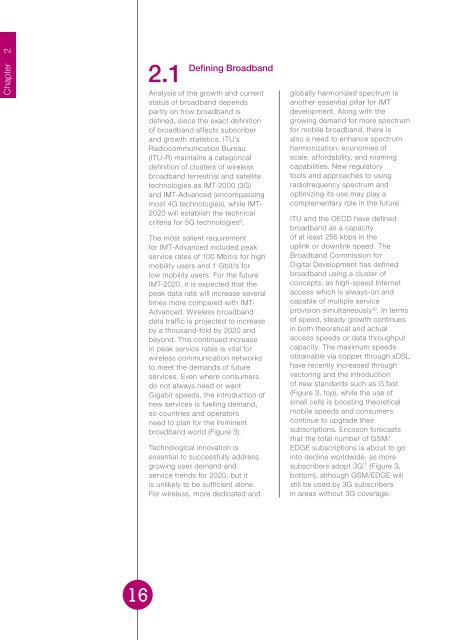DI8xz
DI8xz
DI8xz
You also want an ePaper? Increase the reach of your titles
YUMPU automatically turns print PDFs into web optimized ePapers that Google loves.
Chapter 22.1Defining BroadbandAnalysis of the growth and currentstatus of broadband dependspartly on how broadband isdefined, since the exact definitionof broadband affects subscriberand growth statistics. ITU’sRadiocommunication Bureau(ITU-R) maintains a categoricaldefinition of clusters of wirelessbroadband terrestrial and satellitetechnologies as IMT-2000 (3G)and IMT-Advanced (encompassingmost 4G technologies), while IMT-2020 will establish the technicalcriteria for 5G technologies 9 .The most salient requirementfor IMT-Advanced included peakservice rates of 100 Mbit/s for highmobility users and 1 Gbit/s forlow mobility users. For the futureIMT-2020, it is expected that thepeak data rate will increase severaltimes more compared with IMT-Advanced. Wireless broadbanddata traffic is projected to increaseby a thousand-fold by 2020 andbeyond. This continued increasein peak service rates is vital forwireless communication networksto meet the demands of futureservices. Even where consumersdo not always need or wantGigabit speeds, the introduction ofnew services is fuelling demand,so countries and operatorsneed to plan for the imminentbroadband world (Figure 3).Technological innovation isessential to successfully addressgrowing user demand andservice trends for 2020, but itis unlikely to be sufficient alone.For wireless, more dedicated andglobally harmonized spectrum isanother essential pillar for IMTdevelopment. Along with thegrowing demand for more spectrumfor mobile broadband, there isalso a need to enhance spectrumharmonization, economies ofscale, affordability, and roamingcapabilities. New regulatorytools and approaches to usingradiofrequency spectrum andoptimizing its use may play acomplementary role in the future.ITU and the OECD have definedbroadband as a capacityof at least 256 kbps in theuplink or downlink speed. TheBroadband Commission forDigital Development has definedbroadband using a cluster ofconcepts, as high-speed Internetaccess which is always-on andcapable of multiple serviceprovision simultaneously 10 . In termsof speed, steady growth continuesin both theoretical and actualaccess speeds or data throughputcapacity. The maximum speedsobtainable via copper through xDSLhave recently increased throughvectoring and the introductionof new standards such as G.fast(Figure 3, top), while the use ofsmall cells is boosting theoreticalmobile speeds and consumerscontinue to upgrade theirsubscriptions. Ericsson forecaststhat the total number of GSM/EDGE subscriptions is about to gointo decline worldwide, as moresubscribers adopt 3G 11 (Figure 3,bottom), although GSM/EDGE willstill be used by 3G subscribersin areas without 3G coverage.16


